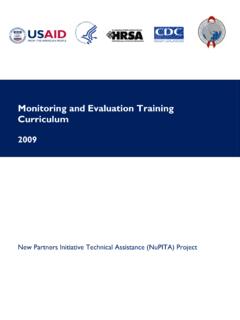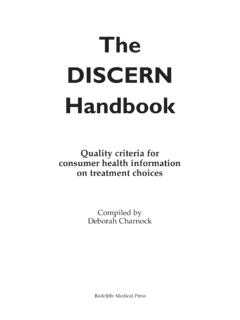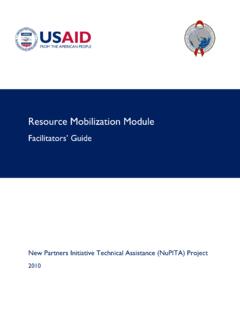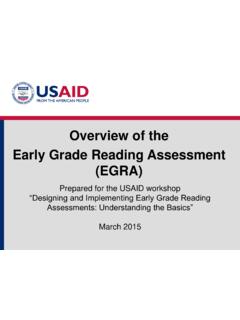Transcription of Comprehensive Guidance and Counselling Programs: The ...
1 6 Canadian Journal o f Counselling I Revue canadienne de counseling I 2002, V o l . 36:1. Comprehensive Guidance and Counselling programs : The Beechville-Lakeside-Timberlea Experience Janice G r a h a m - M i g e l Halifax Regional School Board ABSTRACT. This manuscript provides an overview of the Comprehensive Guidance and Counsel- ling Program in the Beechville-Lakeside-Timberlea (B-L-T) Community. It focuses on program development, including the needs assessment and description of programs designed to meet specific needs of students (self-esteem, anger management, conflict resolution, study skills, work habits, career education, peer support programs , student wellness, the B-L-T Teen Health Centre, etc.)
2 , program evaluation, staff training, and community involvement. This overview illustrates how the Comprehensive Guidance and Counselling Program takes on the challenge of meeting the needs of the whole person in children and adolescents. RESUME. Cet article fournit un aper u general du programme int gr d'orientation et de counseling { Comprehensive Guidance and Counselling Program) de la communaut de Beechville- Lakeside-Timberlea (B-L-T). Il se concentre sur l' laboration de programme, qui comprend, entre autres, l' valuation des besoins et la description des programmes con us pour r pondre aux besoins particuliers des l ves (l'estime de soi, la ma trise de la col re, la r solution de conflits, les techniques d' tude, les habitudes de travail, la pr paration une carri re, les programmes de soutien par les pairs, le bien- tre des l ves, le Centre de sant.}
3 Pour adolescents de B-L-T, etc.), l' valuation des programmes, la formation du personnel et la participation communautaire. Cet aper u g n ral montre comment le programme int gr d'orientation et de counseling entreprend de r pondre aux besoins de la personne toute enti re chez les enfants et les adolescents. A Comprehensive Guidance and Counselling Program is designed to assist the personal, social, educational and career development of students. It is a total school program that requires a professionally qualified Guidance counsellor for full implementation (Nova Scotia Department of Education and Culture, 1999). The program has defined benefits and outcomes for all students and is developed locally through needs assessments within provincial guidelines.
4 There are four main components of the program: 1. Guidance Curriculum: Structured experiences presented systematically through classroom group activities. 2. Professional Services: Counselling , consultation and coordination activities to meet the immediate needs and concerns of students. 3. Life/Career Planning: Activities which assist students to monitor and manage their own learning and make plans for life and career development. 4. Program Management and System Support: Activities which establish, manage, maintain and enhance the program. Comprehensive Guidance and C o u n s e l l i n g programs 7. HISTORY OF T H E PROGRAM.
5 In June 1996, Beechville-Lakeside-Timberlea (B-L-T) School, was chosen by the Nova Scotia Department of Education to pilot a Comprehensive Guidance and Counselling Program during the 1996-97 school year. B - L - T School, repre- senting the Halifax Regional School Board, was one of seven sites across the province. B - L - T School had a population of over 1200 students in Grades Pri- mary to Nine. In August 1996, training was provided by the Department of Education for Guidance counsellors and representative school administrators. In October 1996, a full-day inservice was held at B - L - T School to explain the program to staff members.
6 The design phase took place during the 1996-97 school year and the implementation phase occurred during following two years. The program is now in its fifth year of operation and has moved to a new school that was built in Beechville, called Ridgecliff Middle School (Grades 6 to 9), which opened in September 1999. In this manuscript, I provide a practical overview of the pro- gram and its development. It represents a Guidance counsellor's perspective, out- lining the various components of the programs that were initiated to meet the needs of students. FORMATION OF T H E ADVISORY COMMITTEE. A Comprehensive Guidance and Counselling Advisory Committee was formed in November 1996.
7 The Advisory Committee, coordinated by the guid- ance counsellor, was comprised of administrators (principal and vice principal), teachers from various grade levels, two senior students in Grade 9 (representing both the English and French Immersion programs ), parents, and community members. Input was also given to the committee by the Guidance consultant from the Department of Education. The purpose of the committee was to give members an opportunity for meaningful input into Guidance and Counselling programs and services. Its mandate was to conduct a needs assessment at B - L - T. School, determine what resources are available, and assist in designing and im- plementing programs to meet those needs.
8 During the first year of the program, the Advisory Committee met each month for two hours. Regular monthly meetings were necessary for the design and compilation of data from the needs assessment. During subsequent years, the meetings were held every second month, with subcommittee meetings held on an as-needed basis. NEEDS ASSESSMENT. A needs assessment was designed by the members of the Advisory Committee. School staff completed a questionnaire , students from the Advisory Committee held student focus groups, and the entire student population partici- pated in a needs assessment in the classroom. Parents and community members also participated in the needs assessment through a survey devised by parent and community members on the Advisory Committee.
9 Janice G r a h a m - M i g e l According to the needs assessment completed during the 1996-97 school year, the top five priority issues at B - L - T School, in order of importance, were as follows: Anger management/conflict resolution, work habits/study skills, career education, communication skills, and self-concept/self-esteem. A goal of the A d - visory Committee was to have three issues that the entire school could work on during the school year. Therefore, the Advisory Committee decided to concen- trate school-wide efforts (Grades Primary to Nine) on the first three priority issues. These issues continued to be a priority during the next two school years, as the consensus was that additional time needed to be spent on these issues in order to make a difference.
10 IMPLEMENTATION PHASE. The following is an outline of how B-L-T's Comprehensive Guidance and Counselling Advisory Committee addressed the above-mentioned priority issues: Anger Management/Conflict Resolution After attending a Second Step Violence Prevention "train the trainer" program in October 1997, I provided training in Second Step to teachers from various grade levels at B - L - T School. This training, which took place in March 1998, assisted teachers with the use of Second Step as a violence prevention curriculum. Financial contributions from the school, Parent-Teacher C o - O p , and grant mon- ies enabled B - L - T School to purchase Second Step kits (Committee for C h i l - dren, 1998) to be used in the classroom.
















